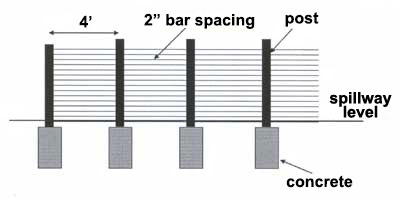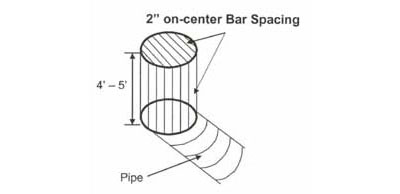Triploid Grass Carp Permitting
Triploid grass carp is a sterile (non-reproducing) form of grass carp. This fish is primarily a plant-eater and is a relatively inexpensive and effective biological tool to control some, but not all, species of nuisance aquatic vegetation. A permit is required to possess, transport, and stock triploid grass carp in public or private water per the regulations in the Texas Administrative Code.
- Step 1: Identify Your Vegetation
- Step 2: Apply for a Permit to Stock Triploid Grass Carp
- Step 3: Purchase Triploid Grass Carp
- Contact Us
Step 1
Identify Your Vegetation
Before deciding to stock grass carp, it's important to identify the vegetation you want to control. Grass carp are effective for bushy pondweed, American pondweed, and hydrilla. Grass carp are not effective for bulrush, filamentous algae (pond scum or moss), water primrose, coontail, Eurasian milfoil, or cattails.
Plant Identification Tool: AquaPlant – a Diagnostics Tool for Pond Plants and Algae, provided by Texas A&M AgriLife Extension, is an excellent source for plant identification and plant control information.
It may take several years to achieve control using triploid grass carp (see stocking guidelines).
Step 2
Apply for a Permit to Stock Triploid Grass Carp
Notice of Permitting Agreement
It is the responsibility of the applicant to read and understand the information provided on triploid grass carp regarding the record-keeping, stocking guidelines, preventing escape, and permitting information.
Approval of the application is not guaranteed. Applications will be reviewed by a department representative, and stocking of triploid grass carp may not be authorized in environmentally sensitive areas where threatened, endangered, or unique species occur. Please allow up to four weeks for the review of your application.
Apply for a PermitTo apply for a permit to stock triploid grass carp, visit the Texas Parks and Wildlife Permitting page. New applicants will then select "Create Account.' If you have a TWIMS, LMA or existing permitting account, login using your email address and password.
Troubleshooting
If you receive an error message, email us with your full name, phone, TxDL and DOB. We will contact you via e-mail once we have processed your request, usually within three to five business days.
An email address is required to access the permit system. If you do not have an email address, you may create a free one with a Gmail or Yahoo account or contact a trusted friend or relative to assist you.
Application Fees
Private Water Applicants
Applications for private water will be charged an application fee comprised of two parts:
- $16.00 non-refundable processing fee, used to fund administrative costs of the triploid grass carp permitting process
- $2.00 per carp; this fee is refundable if the quantity of carp requested is partially or completely denied
Applicants have the option to pay with a debit or credit card or pay by check. Payments by check must include the remittance document created at the time of check out.
Triploid grass carp must be purchased from a permitted vendor.
Public Water Applicants
Fees are waived for public water applications. Public water bodies are defined as bays, estuaries, and water of the Gulf of Mexico within the jurisdiction of the state, and the rivers, streams, creeks, bayous, reservoirs, lakes, and portions of those waters where public access is available without discrimination.
Controlling authorities are advised to contact the permit coordinator or TPWD Inland Fisheries Management District prior to applying. Inland Fisheries Management Regions and Districts
Triploid grass carp must be purchased from a permitted vendor.
Step 3
Purchase Triploid Grass Carp
The link below includes a list of individuals/companies permitted to sell triploid grass carp in the state of Texas. Out-of-state companies delivering/selling triploid grass carp in Texas must be permit holders.
Permitted Vendors for Triploid Grass Carp
Holders of triploid grass carp permits for pond stocking may travel outside the state to purchase triploid grass carp from lawful sources in another state, provided the fish are accompanied on import into Texas by an aquatic product transport invoice and documentation that the grass carp have been certified as triploid by the grass carp Inspection and Certification Inspection Program operated by the U.S. Fish and Wildlife Service.
Permit Requirements and Recordkeeping
All persons in possession of triploid grass carp must possess and retain the following:
- Exotic species transport invoice from a permitted seller in Texas OR aquatic product transport invoice if obtained out of state
- Documentation that the grass carp have been certified as triploid by the Grass Carp Inspection and Certification Inspection Program operated by the U.S. Fish and Wildlife Service
These documents must be retained for a period of one year from the date the grass carp were obtained or as long as the grass carp are in the water.
Permits are valid for the quantity and waterbody specified on the permit.
Permits are valid for 36 months from the date of issuance, or until all grass carp authorized by the permit have been purchased/stocked, whichever occurs first. A permittee may purchase fewer carp than the total quantity permitted; the remaining quantity may be purchased prior to the permit expiration date of 36 months from the date of issuance but cannot be purchased/stocked after the permit expires.
Stocking Guidelines
It may take several years to achieve control using triploid grass carp. Restocking, generally every 5 to 7 years, is needed for maximum effectiveness.
The recommended stocking rate for triploid grass carp is five per acre if the water body has 50% or less plant coverage, and up to 10 per acre if plant coverage is greater than 50%.
The permit system calculates the recommended quantity of carp based on the inputs from the applicant. Requesting greater quantities of carp than the recommended amount is not advised. If overstocked, all submersed aquatic plants may be eliminated. If insufficient numbers are stocked, less-favored plants may become overabundant.
Triploid grass carp should be 10-12 inches long when stocked. Smaller carp are likely to escape or be eaten by predator fish such as catfish or bass. Notify the aquaculture vendor if large catfish or bass are present in the water body.
Early spring is the ideal time to stock. To enhance the effectiveness of triploid grass carp, overabundant vegetation can first be reduced by winter die-off, herbicide treatment, or water-level drawdown to promote grazing on re-growth.
Preventing Escape
Triploid grass carp seek flowing water and often escape before controlling nuisance aquatic plants. Escape of grass carp from the water body where they’re stocked reduces or eliminates the potential for plant control within targeted areas and threatens beneficial plants outside of targeted areas. If they escape, they may have negative impacts on native ecosystems. Impoundments on permanently flowing creeks, or those that overflow frequently, should not be stocked with triploid grass carp unless they can be effectively screened. Emigration barriers are required for many and recommended for most, water bodies being stocked with triploid grass carp. Ensuring that triploid grass carp remain where they are stocked makes economic sense for the water body owner and helps protect beneficial aquatic vegetation in our public waters. In cases where emigration cannot be prevented, chemical or mechanical control of aquatic plants is recommended.

With few exceptions, the best screening device for nearly all outlet types is the horizontal parallel steel-bar design. The orientation of the bars allows unrestricted passage of small debris, thereby minimizing maintenance, clogging, and flooding concerns. Bar thickness of ¼- to ½- inch is preferred. Round bar stock will facilitate debris passage. For a spillway barrier (Figure 1), the horizontal bars are attached to vertical support posts (minimum ¾-inch diameter) spaced 4 feet apart. Horizontal bars should be spaced 2 inches apart. The barrier should span the entire spillway. Since triploid grass carp are excellent jumpers, barrier height should extend 2 feet above the normal high-water level.

For capping a drainage pipe (Figure 2), a similar bar design should be used. Extending the bars 4-5 feet above the overflow pipe allows water to rise over debris and begin flowing again should the screen become clogged.
Welded wire and chicken wire are not effective as barrier materials. These types of materials readily clog with debris and the force of even a small amount of water can destroy the barrier. Clogged barriers may threaten the integrity of dams.
Contact Information
Email the Triploid Grass Carp Permit Coordinator at ifpermits@tpwd.texas.gov.